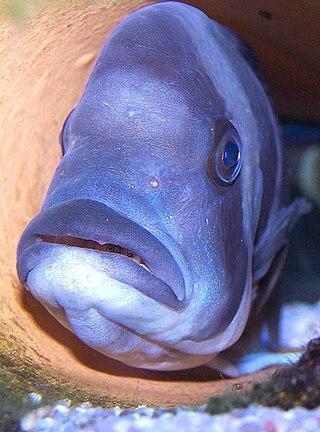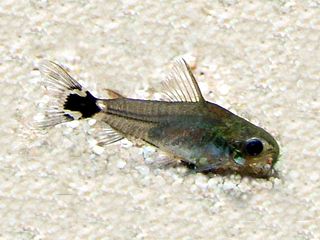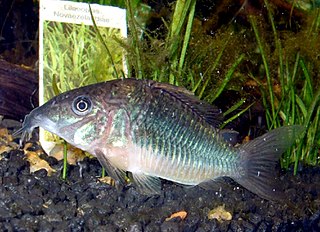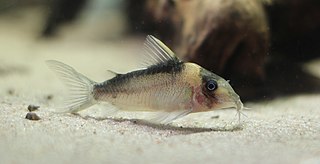
Ancistrus is a genus of nocturnal freshwater fish in the family Loricariidae of order Siluriformes, native to freshwater habitats in South America and Panama. Fish of this genus are common in the aquarium trade where they are known as bushynose or bristlenose catfish. In the aquarium hobby they are often referred to as bushynose or bristlenose plecos instead, but this may lead to confusion as "pleco" usually is used for Hypostomus plecostomus and its allies and is often used as a catchall term for any loricariids remotely resembling that species.

Mouthbrooding, also known as oral incubation and buccal incubation, is the care given by some groups of animals to their offspring by holding them in the mouth of the parent for extended periods of time. Although mouthbrooding is performed by a variety of different animals, such as the Darwin's frog, fish are by far the most diverse mouthbrooders. Mouthbrooding has evolved independently in several different families of fish.

Sterba's corydoras is a member of the South American Corydoras genus of freshwater aquarium catfish and one of the most popular species of Corydoras due to its attractive markings. The fish is native to the Guaporé River region between Bolivia and Brazil.

The red-tailed black shark, also known as the redtail shark, red tailed shark, and redtail sharkminnow, is a species of tropical freshwater fish in the carp family, Cyprinidae. It is named after its shark-like appearance and movement, as well as its distinctive red tail. Despite its name, it is more closely related to carp. It is endemic to streams and rivers in Thailand and is currently critically endangered. However, it is common in aquaria, where it is prized for its deep black body, and vivid red orange tail. These are moderately sized tropical aquarium fish who are active benthic swimmers. They are omnivorous but are willing to scavenge if the opportunity arises. They are known for their activity as well as their temperament towards other fish. The red-tailed black sharks seen in the aquarium trade today are all captive bred.

Panaque nigrolineatus, the royal panaque, royal plec, or royal pleco, is an herbivorous freshwater armored catfish native to Brazil, Colombia and Venezuela where it occurs in the Orinoco and Amazon basins. It is known for being one of the few fish that digest wood. They are able to survive for a long period of time only on a wood-only, xylophagous diet. It grows to a length of 43.0 centimetres (16.9 in) and is a popular aquarium fish.

Corydoras paleatus is a species of catfish of the family Callichthyidae. Its common names include blue leopard corydoras, mottled corydoras, and peppered catfish. It originates from the lower Paraná River basin and coastal rivers in Uruguay and Brazil.

Hoplisoma panda, formerly known as Corydoras panda, is a species of catfish belonging to the genus Hoplisoma, of the family Callichthyidae, and is a native member of the riverine fauna of South America. It is found in Peru and Ecuador, most notably in the Huánuco region, where it inhabits the Río Aquas, the Río Amarillae, a tributary of the Río Pachitea, and the Río Ucayali river system. The species was first collected by Randolph H. Richards in 1968, and was named Corydoras panda by Nijssen and Isbrücker in 1971. The specific name is an allusion to the appearance of the fish, which possesses large black patches surrounding the eyes, reminiscent of those found on the giant panda. Accordingly, the common names for this fish are panda corydoras,panda catfish, and panda cory.

Pterygoplichthys gibbiceps is a species of armored catfish native to Brazil, Ecuador, Peru and Venezuela where it is found in the Orinoco and Amazon basins.

The dwarf corydoras, dwarf catfish, tail spot pygmy catfish, or micro catfish is a tropical freshwater fish belonging to the subfamily Corydoradinae of the family Callichthyidae. It originates in inland waters in South America, and is found in the Amazon River and Paraguay River basins in Argentina, Bolivia, and Brazil. The specific epithet hastatus means with a spear, in reference to the spearhead-like spot on the tail root.

The emerald catfish is a tropical freshwater fish belonging to the Corydoradinae sub-family of the family Callichthyidae native to the Amazon Basin in South America. It has traditionally been known as Brochis splendens. The fish has appeared on a stamp in Brazil.

Hemigrammus erythrozonus, commonly known as the glowlight tetra, is a small tropical fish from the Essequibo River, Guyana, South America. It is silver in colour and a bright iridescent orange to red stripe extends from the snout to the base of its tail, the front of the dorsal fin being the same color as the stripe. Other fins are silver to transparent. The glowlight tetra is a peaceful, shoaling fish. It is larger than the neon tetra, and its peaceful disposition makes it an ideal, and popular, community tank fish. It should be kept with similar sized, non-aggressive species. Hemigrammus gracilis is a senior synonym. The red-line rasbora of Malaysia and Indonesia has markings and coloring very similar to H. erythrozonus, but is a member of family Cyprinidae, not a close relative.

Baryancistrus is a genus of freshwater Loricariid catfish. They inhabit flowing sections of rivers, especially clearwater, in the basins of the Amazon and Orinoco in Brazil and Venezuela. The largest species reach up to 34 cm (13 in) in total length.

Mikrogeophagus altispinosus is a species of fish endemic to the southern Amazon River basin in Brazil and Bolivia. The species is part of the family Cichlidae and subfamily Geophaginae. It is a popular aquarium fish, traded under the common names Bolivian butterfly, Bolivian ram, Bolivian ram cichlid, and ruby crown cichlid.

Panaqolus maccus, commonly called the clown panaque, clown plecostomus, clown pleco, or ringlet pleco, is a dwarf loricariid. By numbering systems such as the L-number system, this fish may also be known as L104, L162, or LDA22.

Hypancistrus is a genus of loricariid catfish originating from the Amazon basin in South America. Unlike many of the other Loricariids, however, some Hypancistrus species are more carnivorous and enjoy meat in their diet. Hypancistrus species are popular aquarium fish, including such popular fish as the zebra pleco and Queen Arabesque pleco.

Hyalobagrus is a genus of bagrid catfishes found in Southeast Asia.

Apistogramma hongsloi is a species of dwarf cichlid fish, native to the Orinoco basin in South America. They are often kept in the aquariums and prefer to have soft, acidic water.

Corydoras rabauti, also known as the rust corydoras, or Rabaut's corydoras is a small species of tropical freshwater armoured catfish native to the Upper Amazon, Solimões, and Rio Negro basins in South America. It was first described by the American ichthyologist Francesca Raimonde La Monte in 1941, and is frequently seen in the aquarium trade.

Corydoras imitator is a small species of tropical freshwater armoured catfish native to the Upper Amazon, Solimões, and Rio Negro basins in South America. It was first described by the Dutch ichthyologists Han Nijssen and Isaäc J. H. Isbrücker in 1983, and is frequently seen in the aquarium trade.
Pseudacanthicus pirarara is a species of catfish in the family Loricariidae native to South America. It was described in 2016 by Carine C. Chamon of the Federal University of Tocantins and Leandro M. de Sousa of the Federal University of Pará, primarily on the basis of the species' unique coloration and patterning. Its specific epithet, pirarara, derives from a Tupi word meaning "macaw-fish", which is frequently used in Brazil to refer to the redtail catfish. It is known that P. pirarara is referred to as the assacu-pirarara by Brazilian fishermen, alluding both to its coloration and its spines, as assacu refers to the spine-covered tree Hura crepitans.




















